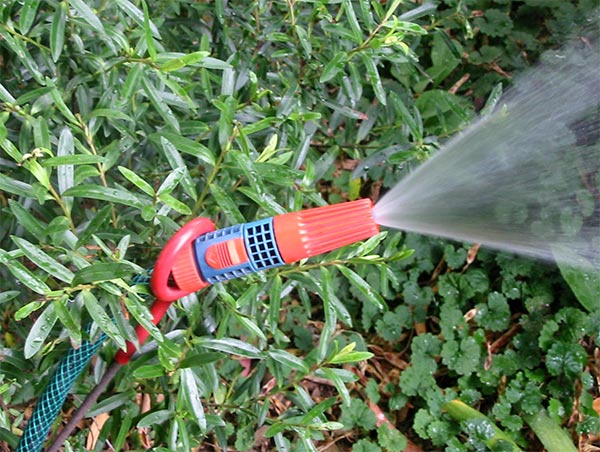 While there is no one answer to the question of how much water is just right for all gardens, there are some useful general guidelines. The most efficient and cost-effective way to water any plant is to fill the entire root zone with water, and let the soil become almost dry be fore the next watering. The amount of dryness depends on the plant. Let the top 2 or 3 inches dry out for most established plants. Let the soil around a large tree dry down several inches, but keep new or tiny plants moist to the top inch or so of soil.
While there is no one answer to the question of how much water is just right for all gardens, there are some useful general guidelines. The most efficient and cost-effective way to water any plant is to fill the entire root zone with water, and let the soil become almost dry be fore the next watering. The amount of dryness depends on the plant. Let the top 2 or 3 inches dry out for most established plants. Let the soil around a large tree dry down several inches, but keep new or tiny plants moist to the top inch or so of soil. Water most plants deeply and infrequently. When using a sprinkler, measure how many inches of water you apply by setting jars at intervals along sprinkler pathways. This will also tell you if the sprinkler gives even coverage.
Remember soil type affects how much water is necessary. Water sandy soils more frequently than clay soil. To make sure you are delivering enough water to where it is needed, use a soil probe or shovel before you water to determine the extent of dryness. Repeat the process after watering to see how deeply the water has penetrated into the soil.
Lawns. Use an overhead sprinkler. Water to a depth of at least 6 inches as soon as grass fails to spring up after walking on it. Avoid frequent, shallow waterings as they lead to shallow roots, which are far more susceptible to heat or drought. Aeration, or removal of soil plugs, helps send water to the root zone. Renting an aerator every other year or so also will help to reduce thatch build-up and combat compaction.
Vegetables, Bedding Plants, and Perennials. Water 6 to 12 inches deep every four to ten days for established plants. Don't wait for plants to wilt before the next watering. Wilting slows growth and reduces crop yields.
Soaker hoses or drip irrigation are efficient ways to water here. They can save up to 60 percent of the water used by a sprinkler. Place mulch over the hose to prevent evaporation.
A cheap version of drip irrigation is container watering. Bury a container, such as a plastic 1-gallon milk jug that has had 2 or 3 holes punched in the bottom, next to or between individual plants. Keep the containers filled with water and allow them to seep water directly into plant root zones. Tailor the size of the container to the size of the plant.
Sprinklers are not the best for vegetable gardens because they waste a vast amount of water. More water lands on the leaves, where it evaporates, than anywhere else. Hand watering is as much a waste of time as it is water. Unless you stand there for a few hours with a water wand, you cannot wet the soil deeply enough to do a worthwhile job.
Cultivate unmulched soil to increase water absorption. Crusted soil forms a barrier against water penetration.
Trees, Shrubs, and Landscape Plants. Water throughout the drip line of plants for the most efficient intake of water. Soaker hoses (see page 31) allow you to wind around individual plants. They are great for such shrubs as roses that are susceptible to moisture-loving disease organisms. Since no water rests on the leaves the diseases can't establish their spores. To allow water to slowly seep down into the soil, mound a ridge of soil around the outside of the drip line to form a basin and fill with water. Remove this soil during rainy weather to prevent waterlogged roots.
Plants on landscape berms. Check and water more frequently since they have more exposed soil from which water may evaporate.
New woody transplants. Water thoroughly both the nursery soil within the root ball and the native soil surrounding it. Failure to do so may prevent the roots from venturing into the surrounding soil, which can eventually kill the plant. Dead plants are an investment wasted.
Plants in containers. Water as soon as the surface feels dry. Keep a close eye on thirsty plants such as fuschias, which often need watering once or twice daily in hot, dry weather.

No comments:
Post a Comment